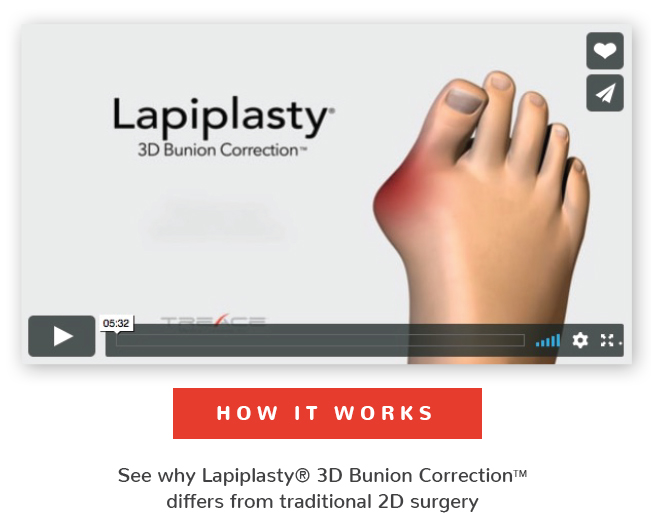
Bunion Surgery
A bunion is bony prominence caused by mal alignment of the bones in the foot. Bunions result in pain, swelling and deformity of the foot and make it difficult to find comfortable shoes. Bunion surgery can be performed to realign the joint, correct the deformity, and relieve the pain and discomfort.
Surgery is the only means of correcting a bunion. Surgery is also recommended when conservative measures fail to treat the symptoms of a bunion.
There are many surgical options to treat a bunion. The common goal is to realign the bones in the foot, correct the deformity, and relieve pain and discomfort. The surgery is performed under general anesthesia, sometimes with a regional nerve block to help with pain afterwards.
There are many different ways to treat bunions based on the severity of the deformity and presence of arthritsis. Sometimes a combination of techniques are used. Most commonly the below techniques are utilized.
Distal Chevron Osteotomy with an Akin Osteotomy
This technique is best for more moderate bunion deformities. During the procedure, the surgeon will make an incision over your big toe joint to perform the distal chevron osteotomy first. The joint capsule is opened, and the prominence is shaved down using a surgical saw. A V-shaped cut is made on your big toe and the metatarsal bone is shifted to bring your toe into a more normal anatomical position. The bunion is then shaved, and the soft tissues are realigned to correct the position. To get an even better visual alignment, often an Akin Osteotomy is necessary. Akin osteotomy corrects the sideways deviation of the tip of the big toe. In this part of the procedure, your surgeon makes a small cut in the proximal phalanx (base of the big toe) and removes a wedge of bone to straighten the big toe. The bony fragments are then stabilized using a screw or staples.
First Metatarsalphalangeal Joint Arthrodesis
This option is reserved for patients with significant arthritis at the big toe joint. It is fusing the big toe joint in an appropriate position that allows for normal function of the foot, but gets rid of the bunion pain. During this procedure, the surgeon will make an incision over your big toe joint. The the diseased remaining cartilage and bone is removed. Toe is brought into a good position and a plate with screws is placed to maintain it. The 2 bones will then grow together. This eliminates the pain from the bunion and arthritis very successfully, but does get rid of some motion. Functionally though, a fusion of the big toe doesn’t affect most people’s athletic activities.
First Tarsametatarsal Joint Arthrodesis
This procedure is an excellent option for patients with moderate to severe bunion deformities and no/minimal arthritis at the big toe joint. In this surgery the alignment is corrected through the joint closer to the ankle than the big toe joint (the 1st TMT joint). This allows the preservation of big toe joint motion and the normal TMT joint only has around 1 degree of motion which is usually not noticed. The Lapiplasty procedure is an excellent way to achieve this reliable correction.
Risks and Complications of Bunion Surgery
As with any surgery, bunion surgery involves certain risks and complications. They include:
- infection
- recurrence of the bunion
- nerve damage
- unresolved pain and swelling
- joint stiffness or restricted movement
- Delayed healing or healing in the wrong position
In rare cases, a second surgery may be necessary to correct the problems.
Post-Operative Care of Bunion Surgery
Patients should follow all instructions given by the surgeon following the surgery. These include:
- Keep your dressings dry and leave them in place until your next outpatient appointment.
- Do not place any weight on the operative leg.
- Elevate the foot to minimize swelling as much as possible for the first 6 weeks.
- Use crutches, walker or wheelchair to assist in getting around.









